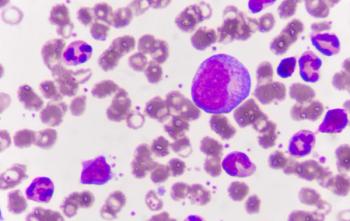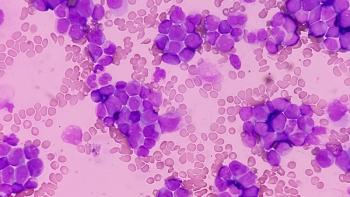
Inguinofemoral Radiotherapy May Be Potential Alternative To Lymphadenectomy In Select Vulvar Cancer
Inguinofemoral radiotherapy may be a safe alternative for patients with vulvar cancer and sentinel node micrometastases who might otherwise face the morbidity of a lymphadenectomy.
Findings from a phase 2 trial suggest that patients with vulvar cancer and sentinel micrometastases may be able to avoid the morbidity of a lymphadenectomy by receiving inguinofemoral radiotherapy. Full study results the trial, 1 GROINSS-V-II ((NTR608/NL552) were recently published in the Journal of Clinical Oncology.1
Of a total of 1535 patients registered to the trial, 21.0% (n = 322) had sentinel node metastasis. The stopping rule was activated in June 2010 because the isolated groin recurrence rate in 91 patients with sentinel node positivity went above the predefined threshold for the trial.
In 10 patients who had isolated groin recurrence, 9 had sentinel node metastases that were bigger than 2 mm and/or they had extracapsular spread. The trial protocol was amended so that those with macrometastases in the sentinel node, which was defined as bigger than 2 mm, received standard-of-care inguinofemoral lymphadenectomy (IFL). Those with sentinel node micrometastases, defined as smaller than 2 mm, continued to receive inguinofemoral radiotherapy.
Of the 160 patients with sentinel node micrometastases, 126 were given inguinofemoral radiotherapy and experienced a 2-year ipsilateral isolated groin recurrence rate of 1.6%. In the 162 patients with macrometastases in the sentinel nodes, the 2-year ipsilateral isolated groin recurrence rate was 22% in those who received radiotherapy and 6.9% in those given standard of care (P = .011).
“GROINSS-V-II demonstrated that inguinofemoral radiotherapy in patients with sentinel node micrometastases results in a very low isolated groin recurrence rate, with acceptable treatment-related morbidity,” Maaike H. M. Oonk, PhD, of the Department of Obstetrics and Gynecology at The University Medical Center Groningen, The Netherlands, and colleagues, wrote. “For patients with sentinel node macrometastases, inguinofemoral radiotherapy with a total dose of 50 Gy is not a safe alternative for IFL in view of the higher risk of isolated groin recurrence.”
Over the past decade, several advances have been made in the treatment of patients with early-stage vulvar cancer. In those with unifocal tumors that are smaller than 4 cm and nonsuspicious groin nodes, a sentinel node biopsy has become standard of care rather than elective IFL. However, for those with sentinel node metastases, further treatment with IFL remains standard.
The GROINSS-V-I trial demonstrated that inguinofemoral lymphadenectomy can be safely omitted in patients who have negative sentinel nodes, leading to a significant decrease in morbidity. Patients with metastases in the sentinel node still need to undergo IFL to prevent groin recurrences, which are often fatal.
Investigators launched GROINSS-V-II to identify an equally effective, but less morbid, approach for patients with a metastatic sentinel node. To do this, they set out to determine whether inguinofemoral radiotherapy may represent a safe alternative to IFL in this population. They also wanted to examine the short- and long-term treatment-related morbidity for this strategy.
The prospective, multicenter, single-arm trial enrolled patients with early-stage vulvar cancer who were planned to undergo surgery. To be eligible for enrollment, patients needed to have unifocal microinvasive squamous cell carcinoma of the vulva that was less than 4 cm, and preoperative imaging of their groins could not reveal any suspicious nodes.
The primary end point of the research was the 24-month isolated groin recurrence rate.
Investigators utilized a radioactive tracer with performance of a lymphoscintigram and blue dye to perform sentinel node biopsies on study participants. When metastases were identified, the size and presence of extracapsular spread were noted. If the sentinel node could not be identified, an IFL was recommended. If the sentinel node was negative following ultrastaging, no further treatment was given. If tumor cells were detected, patients were regarded to have metastatic disease.
If metastatic disease in the sentinel node was identified, inguinofemoral radiotherapy was indicated. The decision of whether the treatment would be administered to 1 or both sides in those with unilateral sentinel node involvement was dependent on the participating center. Radiotherapy had to be given within 6 weeks after surgery, and it was given at a total dose of 50 Gy in 25 to 28 fractions of 1.8 Gy to 2.0 Gy, 5 fractions per week. The target dose of 50 Gy was selected because it was an effective dose for subclinical disease.
A total of 1708 patients were registered to the trial between December 2005 and October 2016. Among 1535 patients determined to meet the eligibility criteria for the trial, 79.0% (n = 1213) had a negative sentinel node and 21.0% (n = 322) had a metastatic sentinel node. Of the 322 patients with a metastatic sentinel node, 160 had micrometastases and 162 had macrometastases.
Among those with micrometastases, 78.8% (n = 126) were given inguinofemoral radiotherapy. Fourteen of these patients received radiotherapy plus chemotherapy; 9 were given cisplatin, and 5 had cisplatin and fluorouracil. Ten percent of the 126 patients underwent IFL rather than radiotherapy and 11.3% did not receive any further treatment because of either patient refusal, severe comorbidity, or older age.
Among the 160 patients, 6 isolated groin recurrences had occurred at 2 years following primary surgery; the 2-year rate was 3.8% (95% CI, 0.8%-6.8%) in this population. In the 126 patients who were given the radiotherapy, only 2 isolated ipsilateral groin recurrences were observed, in addition to 1 in a contralateral sentinel node–negative groin. Another 2 of 6 groin recurrences were reported in those who did not receive further treatment with IFL or radiotherapy. Additionally, 1 groin recurrence was observed in the contralateral sentinel node–negative groin following unilateral IFL for a metastatic node.
Among the 18 patients who were not given any additional treatment, the ipsilateral isolated groin recurrence rate proved to be higher than what was reported in those who received radiotherapy; the 2-year rates were 11.8% (95% CI, 0.0%-27.2%) and 1.6% (95% CI, 0.0%-3.9%), respectively (P = .006).
Among the 162 patients who had macrometastases, 31.5% received only radiotherapy to the groins and 13.7% received radiotherapy plus chemotherapy in the form of cisplatin. Moreover, 64.8% of these patients (n = 105) had a unilateral or bilateral IFL; 56.2% of these patients also received adjuvant radiotherapy. Six patients did not receive further treatment following the removal of the sentinel nodes.
Among those with macrometastases, 19 groin recurrences were reported. The 2-year groin recurrence rates in those who received radiotherapy vs those who underwent IFL were 22.0% (95% CI, 10.5%-33.5%) and 6.9% (95% CI, 2.0%-11.8%), respectively. One recurrence was observed in a patient with 2 sentinel node macrometastases who did not receive any adjuvant treatment. No recurrences were reported in the contralateral nonirradiated groin.
Among those who received IFL, the groin recurrence rate in those who received adjuvant radiotherapy was not found to differ from those who did not receive adjuvant radiotherapy (P = .43). In the 7 patients who received radiation plus chemotherapy, no recurrences were reported. A trend toward better disease control was observed in those who received this combination (P = .091).
Of the 1213 patients who had sentinel node negativity, 31 had isolated groin recurrences. For 2 patients, metastases were noted to have been present in retrospect. In 4 patients, not all nodes visualized on the lymphoscintigram were removed. No concrete explanations were found for the other cases.
In patients with negative sentinel nodes, the estimated risk of disease-specific death at 2 years was 2.1% (95% CI, 1.3%-2.9%). In those with micrometastases, this rate was 6.5% (95% CI, 2.6%-10.4%); this rate was highest in those with macrometastases, at 25.5% (95% CI, 18.6%-32.5%; P < .0001). At 2 years following primary treatment, OS rates in those with negative sentinel nodes, micrometastases, and macrometastases were 95.2% (95% CI, 94.0%-96.5%), 88.3% (95% CI, 83.2%-93.4%), and 69.3% (95% CI, 62.0%-76.6%), respectively (P < .0001).
Of the 56 patients who experienced recurrence, 31 died from their disease during study follow-up. The estimated risk of disease-specific death at 2 years in those with macrometastases proved to be comparable in those who received IFL with or without radiotherapy and those who only received radiotherapy, at 24.2% (95% CI, 15.7%-32.6%) and 24.4% (95% CI, 12.4%-36.4%), respectively (P = .88). Moreover, 25.5% of patients who received radiotherapy only died of vulvar cancer vs 22.9% of those who underwent IFL.
Notably, a sentinel node biopsy and subsequent radiotherapy to the groins was linked with low-grade toxicity. Cases of nausea, vomiting, mucositis, or anal and urinary incontinence were only grade 1 or 2 in severity. Diarrhea most frequently occurred at 4 to 6 weeks (grade 1, 12.3%; grade 2, 2.3%; grade 3, 0.6%) or 6 months following radiotherapy (7.9%, 0.0%, and 0.7%, respectively).
Moreover, 21.3% of patients reported grade 1 toxicity associated with the skin in the irradiated groin; in 14.8% and 1.3% of patients, respectively, this effect was grade 2 or 3 in severity. However, at 6 months, the incidence of this toxicity was found to significantly decrease. Notably, no grade 4 or 5 effects were observed.
Among patients who experienced lymphedema more than once at 6 months or 12 months following treatment, this effect was less frequent following biopsy alone, at 5.1% and 4.1%, respectively, vs when biopsy was done and followed by radiotherapy, at 16.4% and 10.7%, respectively (P < .0001). The highest incidence of this toxicity was observed in those who underwent IFL, at 32.0% in those who also received radiotherapy and 22.9% in those who did not (P < .001).
“Inguinofemoral radiotherapy for vulvar cancer patients with sentinel node micrometastases appears to be a safe alternative for IFL. The toxicity of radiotherapy is acceptable, and treatment-related morbidity is less frequent compared with IFL,” study authors concluded. “For patients with sentinel node macrometastases, radiotherapy with a total dose of 50 Gy showed more isolated groin recurrences than IFL.”
The GROINSS-V-III trial (NTR7677/NL7435) will examine radiotherapy dose escalation in combination with chemotherapy in patients with sentinel node macrometastases.
Reference
- Oonk MHM, Slomovitz B, Baldwin PJW, et al. Radiotherapy versus inguinofemoral lymphadenectomy as treatment for vulvar cancer patients with micrometastases in the sentinel node: results of GROINSS-V II. J Clin Oncol. Published online August 25, 2021. doi:10.1200/JCO.21.00006
This article was originally published on OncLive as “Inguinofemoral Radiotherapy Represents Safe Alternative to Lymphadenectomy in Vulvar Cancer With Micrometastases”
Newsletter
Knowledge is power. Don’t miss the most recent breakthroughs in cancer care.
















































































